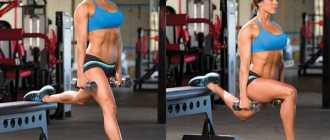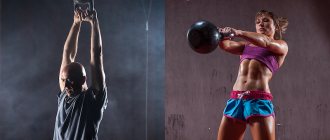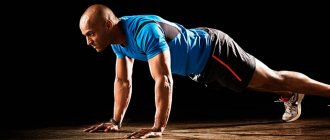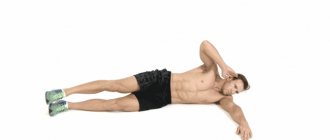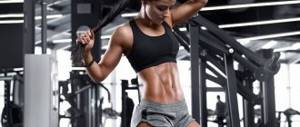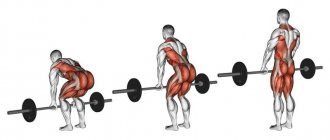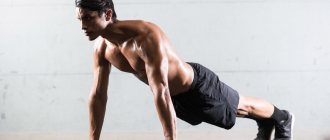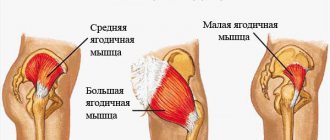Share:
Jump squats are a rather interesting exercise in terms of load, which are deservedly popular among CrossFit and fitness enthusiasts. On the one hand, in it we work out the quadriceps perfectly, working in full amplitude and in an explosive manner, on the other hand, we additionally train our heart, since this exercise also contains aerobic exercise.
Few exercises that do not require the use of additional weights can increase the pace of your workout as much as jump squats. The only things that come to mind are various variations of burpees (with jumping onto a box, jumping over a barbell, pulling up on a horizontal bar, etc.). The work is really colossal: due to the fact that we work non-stop, without giving our muscles a rest, the body does not have time to restore ATP reserves, glycogen reserves in our muscles are quickly consumed, the maximum number of muscle fibers, both fast and slow, and the heart rate can easily reach 140-160 beats per minute, so people suffering from arterial hypertension or other problems with the cardiovascular system should perform this exercise with great caution - such an intense load may be for them excessive and dangerous.
In our article today we will look at the following features of this exercise:
- What are the benefits of jump squats?
- Technique for performing the exercise;
- CrossFit complexes containing this exercise.
Correct technique
If squat jumps are performed without weights:
- Place your feet shoulder-width apart and straighten your back. You can cross your arms in front of you at chest level.
- The squat is done while inhaling. Lower yourself until parallel with the floor. You can go a little lower, the main thing is to watch your feelings.
- As you exhale, you need to make a powerful jump up, pushing off with your full feet. Try to jump as high as possible, your hips should “spring” as much as possible.
- Once your feet have fully touched the floor, squat down again. Repeat squat jumps as many times as necessary.
It is especially important to control your landing: try to plant both feet on the floor at the same time. You should land on slightly bent legs (as softly as possible) and immediately go back into another squat.
It is advisable to use soft and comfortable sports shoes designed for such training, ideally with shock-absorbing soles that can effectively absorb shock. It is also better to choose a surface for practicing, focusing on a softer surface (accordingly, concrete or asphalt surfaces are not the best options).
Jump squats: what to expect from the exercise?
Jump squats are considered an explosive type of exercise because they require increased effort. This is a great way to increase the load, burn more calories, and force the body to get out of its comfort zone.
The benefits and harms of exercise
Here are the benefits of jump squats:
- Exercise increases the tone of the muscles of the thighs, buttocks, abs, and tightens the skin;
- Helps to form a beautiful muscle relief;
- Strengthens the cardiovascular system;
- Actively starts the fat burning process;
- Strengthens the muscle corset, helps improve the sense of balance;
The squat-jump exercise is very effective, especially in interval or circuit training, where cardio is combined with strength training. Please note that there are a number of contraindications in which jumping out of a squat is strictly prohibited.
As we have already said, the exercise belongs to the explosive category - it is performed at a fast pace, powerfully, often in jerks (for example, explosive push-ups with a clap behind the back). It is difficult for an athlete to control the correct position of the body in space, so it is important to thoroughly study and practice the technique. Otherwise, there is a high risk of injury to the knees or spine.
Contraindications include:
- Exacerbations of any chronic diseases;
- Diseases of the heart and respiratory system;
- Conditions after stroke, heart attack;
- Any inflammation, including increased body temperature;
- Poor health (weakness, migraine, headache, blood pressure);
- After abdominal operations;
- Diseases of the leg joints or musculoskeletal system;
- Any conditions incompatible with physical activity.
Execution technique
Let's look at the correct technique for doing a jump squat:
- Starting position – as for classic squats. Feet shoulder-width apart, arms straight along the body, look forward, back straight, knees and toes pointing in the same direction;
- As you inhale, lower yourself down until your thighs are parallel to the floor, forming a 90-degree angle with your knees;
- As you exhale, jump powerfully straight up, reaching for the ceiling with the top of your head;
- Return to the squat position with your knees at 90 degrees;
- Continue jumping at a comfortable or set pace.
The absence of errors guarantees high performance and minimal risk of damage to the athlete’s health.
- When squatting, control the position of your foot - it should not leave the floor at the heel;
- Never round your back. Imagine that they drove a stake into the top of your head, which went through your whole body and came out somewhere in the area, excuse me, butt. Just jump like that. In this case, the body can be slightly tilted forward, allowing the body to intuitively choose a comfortable position.
- The shoulders are kept lowered, the neck is relaxed, the shoulder blades are slightly brought together, the arms are tense and lie along the body. Don't wave them around or let them dangle uselessly. You can take small dumbbells - this will increase the load and keep your hands busy.
- To protect your joints, land softly, pretending there are springs on your soles. Hard and impact jumps can cause sprains or dislocations;
- During the squat, do not bend at the lower back;
- Make sure that your knees do not go beyond the plane of your toes;
- Always land with your legs bent.
First of all, carefully practice the technique of performing jump squats. At first, it is recommended to perform the exercise slowly, without rushing. Listen to your body, feel if your muscles are resisting.
High jump squats have the greatest effect when performed at a high tempo. For beginner athletes, 10-15 jumps in 3 sets are enough, with a break of 30-60 seconds. Strive to regularly increase the load, increase the number of repetitions to 30-40, and approaches to 5-6.
Jump Squat Variations
- In addition to the classic jump up, advanced athletes perform squats with a side jump. This option requires increased control over the position of the body in space.
- If you want to make the task more challenging, use weights such as dumbbells.
- Also, you can try not just jumping, but jumping onto a small elevation.
- Experienced athletes use so-called “ligaments”: they do a squat, touching their palms to the floor, suddenly take a lying position, do push-ups, return to a squat, and jump.
The choice of variation, of course, depends on the athlete’s level of training. To begin with, it is recommended to master the classic version with jumping up. As soon as you realize that this load is not enough, feel free to move on to complication.
Follow your technique and don’t forget about soft and comfortable sneakers!
Source: https://gtonorm.ru/prisedaniya-s-vyprygivaniem/
We use weights
Some athletes use additional weight (for example, dumbbells) or a complication in the form of jumping onto an elevated surface. But this option increases the risk of joint injuries; if you land poorly, you can damage your ankle and sprain ligaments.
If you plan to do weighted jump squats, we recommend using comfortable dumbbells for this purpose. In this case, the technique is adjusted:
- It is better to hold dumbbells in straight arms pointing downwards. The squat is also done while inhaling, the back is straight.
- Push off the floor and jump as high as possible. The arms are still straight and pointing down.
- Soft landing with a squat.
Jump Squats
Jump squats are a rather interesting exercise in terms of load, which are deservedly popular among CrossFit and fitness enthusiasts. On the one hand, in it we work out the quadriceps perfectly, working in full amplitude and in an explosive manner, on the other hand, we additionally train our heart, since this exercise also contains aerobic exercise.
Few exercises that do not require the use of additional weights can increase the pace of your workout as much as jump squats. The only things that come to mind are various variations of burpees (with jumping onto a box, jumping over a barbell, pulling up on a horizontal bar, etc.).
The work is really colossal: due to the fact that we work non-stop, without giving our muscles a rest, the body does not have time to restore ATP reserves, glycogen reserves in our muscles are quickly consumed, the maximum number of muscle fibers, both fast and slow, and the heart rate can easily reach 140-160 beats per minute, so people suffering from arterial hypertension or other problems with the cardiovascular system should perform this exercise with great caution - such an intense load may be for them excessive and dangerous.
In our article today we will look at the following features of this exercise:
- What are the benefits of jump squats?
- Technique for performing the exercise;
- CrossFit complexes containing this exercise.
What are the benefits of jump squats?
Such exercises simultaneously carry an aerobic and anaerobic load for the body, providing comprehensive development of the athlete’s functional capabilities.
- The aerobic component of the exercise is that by working in such an intense manner, we stimulate the work of our cardiovascular system, adapting our heart muscle to a serious load. By working with a high heart rate, we also enhance the process of breaking down fatty tissue, which leads to rapid weight loss and gaining good definition.
- The anaerobic component of the exercise is that our muscles also receive quite a lot of stress, which is necessary for their hypertrophy and increase in strength. By working in this non-stop manner, we increase anaerobic glycolysis, which leads to rapid acidification and “failure.”
Having mastered the correct technique of this exercise and included it in your training program, after some time you will notice how your endurance and explosive strength have increased, you can more easily tolerate intense cardio loads and have better control of your breathing during basic strength exercises.
Therefore, I strongly recommend that every athlete not ignore this exercise and pay due attention to it, whether you are a fan of crossfit, fitness, powerlifting, martial arts or athletics - the functional qualities developed in jumping squats will be useful to you in any of these disciplines, significantly increasing your results.
What muscles work?
In addition, jump squats also stimulate the development of explosive quadriceps strength due to the sharp contraction of muscle fibers.
This will be very useful for us when performing heavy squats and deadlifts, where a good explosion at the start guarantees a quick and powerful lift of the projectile.
Many Western powerlifting instructors make jumping exercises (such as jump squats and box jumps) the primary aid for developing truly strong legs.
The main muscle groups worked during jump squats are the quadriceps, hip adductors and buttocks. Additional static load is carried by the spinal extensors, abdominal muscles and thigh biceps.
The most common variation of jumping is to perform this exercise with the athlete’s own weight - this is the easiest way to control the movement, monitor breathing, and the load on the knees and spine will be minimal.
However, no one forbids you to complicate your task and try to perform this exercise with additional weights in the form of a barbell or dumbbells.
It is best to place the barbell on the trapezoid, as with classic squats, hold the dumbbells in outstretched arms, trying not to strain the biceps and shoulders.
Of course, the weight should be moderate, strength records are not of interest to us here, and there is no point in working in a low rep range. Choose a weight with which you can handle at least 10 “clean” repetitions and gradually increase the load, remembering to give the body enough resources to recover.
The risk of injury from the exercise from using additional weight, of course, increases, since an axial load appears on the spine and creates unwanted compression on the knee joints.
Correct technique for performing the exercise
Below we will look at the most correct technique for performing jump squats, by studying which you can significantly increase the amount of work performed in training.
Starting position
- We place our feet shoulder-width apart;
- The feet are placed slightly apart;
- The back is straight;
- We cross our arms on our chest;
- The gaze is directed forward.
If you are performing an exercise with a barbell, place it on the trapezius muscles and squeeze it tightly with your palms; it should not change its position throughout the approach.
If you are performing the exercise with dumbbells, grab them tightly with your hands (you can use wrist straps or hooks) and try to keep them pointed straight down throughout the entire approach. If the dumbbells swing from side to side, you risk shoulder injury.
Squat
Perform a deep squat, keeping your back straight and not rounding your sacrum. Try to touch your thigh biceps to your calf muscles - this will be our lowest point of amplitude. Do not change the position of the apparatus if you perform the exercise with additional weights.
Jerk
Begin an explosive upward movement, trying to straighten your legs as quickly as possible, and exhale sharply as you do so.
After this, try to lift your feet off the ground; due to the given powerful acceleration, you will lift off the ground by several tens of centimeters. Watch the position of the barbell and dumbbells during the jump.
If you are outweighed and cannot control the movement, reduce the working weight or perform jumping exercises with your own weight.
"Landing"
When you have already started to go down, inhale and concentrate on landing with your legs slightly bent and immediately continue moving down - this way you will minimize the risk of injuring your knee joints.
Land, immediately lower yourself as low as you can and perform one more repetition without pausing after landing or at the bottom.
The work must be continuous so that the thigh muscles are in constant tension.
Crossfit complexes
In the table below we will look at several functional complexes, by performing which you can increase the explosive power of the legs, give a complex load to all the muscles of the body, or simply increase training energy consumption by spending a large number of calories in the gym.
These complexes indicate the number of repetitions of jump squats, implying that the exercise is performed with the athlete’s own weight. If this exercise is very easy for you without using additional weights, you can take a small barbell or light dumbbells and perform these complexes with them, reducing the number of repetitions at your discretion.
| Flight Simulator | Perform 200 jump rope, 60 jump squats and 30 burpees. Only 3 rounds. |
| JAX | Perform 10 burpees, 10 cleans, 20 jump squats and 20 lunges. Only 5 rounds. |
| OHDU | Perform 3 overhead squats, 20 jump squats, and 15 double jump ropes. Only 3 rounds. |
| Red Line | Perform 10 barbell thrusters, 10 box jumps and 10 jump squats. Total 10 rounds. |
Source: https://cross.expert/uprazhneniya/prisedaniya-s-vyprygivaniem.html
Contraindications
Jump squats are contraindicated if you have joint injuries (especially knees) or problems with your back and spine. The presence of cardiovascular diseases is also a signal that requires special caution, and it is better to consult with specialists (doctor and trainer).
Overweight people should also refrain from performing the exercise. In this case, an unacceptable compression load on the spine and knee joints may occur.
